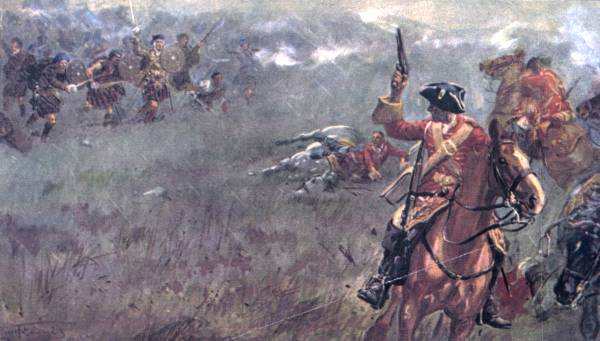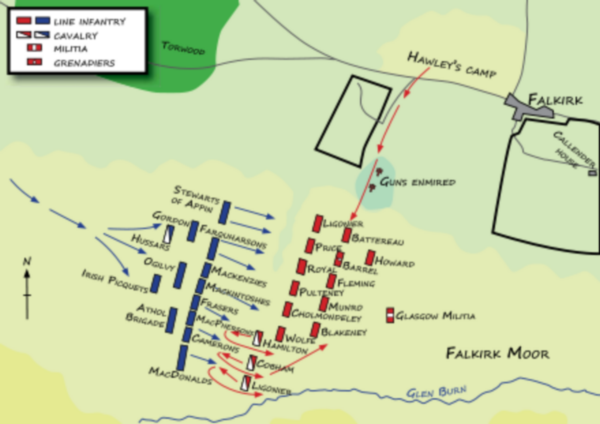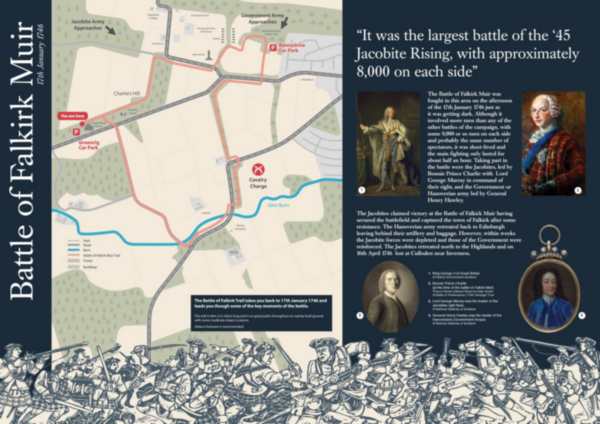Victory at Falkirk Muir for The Prince - January 17th 1746
Third Victory for The Prince after successes at Prestonpans and Inverurie
Alison Campsie in The Scotsman writes - January 17th 2019
In high winds, heavy rain and fading light, the Jacobites won their third and final last victory at the Battle of Falkirk Muir on January 17th 1746. With up to 10,000 Jacobite fighters on the field, including soldiers from France and Ireland, Prince Charles Edward Stuart’s army defeated experienced government forces in around 20 minutes. Some 300 of Lieutenant-General Hawley’s men were killed in action compared to Jacobite losses of around 50 fighters.
Despite the win, Falkirk Muir is described as a hollow victory by some given that the Jacobites failed to capitalise on their success in the field.
While the victory could have potentially instilled fresh valour in the Jacobites following their abandoned invasion of England, events on January 17 1746 failed to improve their fortunes. Instead of seizing upon the result, the Jacobite army instead retreated to the Highlands as infighting and power struggles prevailed.
Dr Arran Johnston, Director of the Scottish Battlefields Trust, said: “This victory was really the last chance for the Jacobites to reassert themselves and the last serious moment where they could have turned it around in their favour.
“That opportunity was lost really due to the structural and psychological problems in the Jacobite army.”
The battle was fought as Jacobites occupied Stirling Castle with a foraging raid on Linlithgow prompting Lt-General Hawley’s men to march out Edinburgh to set up camp to the west of Falkirk. Instead of waiting for the Government force to attack them at Stirling, the Jacobites advanced to the high ground to the south of the town, from where they proposed to attack the Government camp, according to Historic Environment Scotland’s Inventory of Historic Battlefields.
Dr Johnston said half of the Jacobite army was “very successful” on the day of battle and used “very, very disciplined fire power” to drive off the enemy. “The other half found itself in difficult conditions and was unable to sustain attack. You can see at Falkirk both the strengths and the weaknesses of the Jacobite army,” he added.

One tactic used by the Jacobites to fight the British army's dragoons was to thrust their dirks into the horses’ stomachs, before attacking the soldiers as their horses lost balance, according to accounts. Dr Johnston added: “The battle does demonstrate that even after their retreat out of England they are extremely capable but because of internal uncertainty they are back on the road.
“They lost this last opportunity to really take the lead. They don’t follow up the win with a march on Edinburgh, for example.”
Dr Johnston said there were concerns among Jacobite leaders as to how long they could sustain fighting in lowland areas. “There was a sense that they should pull out and move back into the Highlands.
“Charles Edward Stuart took the decision to retreat from Derby very badly. There was internal control for the battle of the Jacobite army. Charles Edward Stuart was starting to lose that battle.
A large body of spectators gathered at Falkirk Muir to watch battle and a number were killed when they were mistaken for enemy troops by the Jacobites. Others were taken into custody for their suspected Government sympathies and locked up in Doune Castle.

The prisoners included John Witherspoon, who escaped from the castle and eventually found his way to America, where he was later to earn fame as a signatory of the Declaration of Independence.
Today, the Falkirk Muir Battlefield Trail has just been created to increase understanding of the encounter and a Museum is in the early planning stages.

Published Date: January 19th 2019
|





